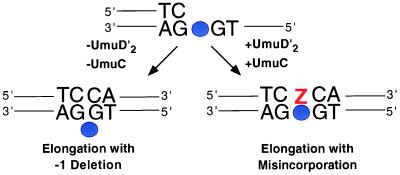Figure 2.
Illustration of the two classes of extended translesion synthesis products observed by Reuven et al. (8). In the absence of UmuD′2 and UmuC, the translesion synthesis product most commonly carried a 1-nt deletion that apparently arose by a slippage mechanism. In the presence of UmuD′2 and UmuC, the predominant translesion synthesis product was of the expected length and apparently rose from the introduction of a nucleotide, most often an A, opposite the abasic site.

